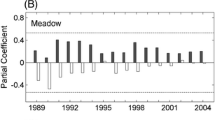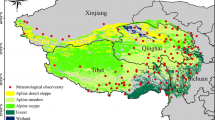Abstract
Though temperature over the past three decades has shown an asynchronous warming trend between daytime and nighttime, the response of vegetation activity to such non-uniform warming is still not very clear. In this study, the least squares linear trend analysis and geographic information system spatial analysis were conducted to analyze the spatiotemporal patterns of the daytime and nighttime warming based on the daily temperature data from 1982 to 2015 in Northwest China. The normalized difference vegetation index (NDVI) from Global Inventory Monitoring and Modeling System and vegetation type data were used to investigate the responses of vegetation activity to the daytime and nighttime warming using the partial correlation analysis. Our results suggested that (1) there was a very significant increasing trend in both daytime and nighttime temperatures in Northwest China from 1982 to 2015; night temperatures increased about 1.2 times faster than daytime temperatures, showing diurnal asymmetric warming; (2) the responses of vegetation activity to daytime and nighttime warming in Northwest China showed a distinct spatial pattern; the change in night temperatures had a more significant (positive in most regions) effect on vegetation; (3) various types of vegetation responded differently to asymmetric daytime and nighttime warming. Grassland NDVI, broad-leaved, and coniferous forest NDVI significantly responded to daytime warming. Shrub NDVI and desert NDVI significantly responded to night warming. These findings can deepen the understanding of the effects of the daytime and nighttime warming on vegetation activities in arid regions in the context of the current asymmetric warming.



Similar content being viewed by others
References
Barton, B. T., & Schmitz, O. J. (2018). Opposite effects of daytime and nighttime warming on top-down control of plant diversity. Ecology, 99, 13–20.
Chen, A., He, B., Wang, H., Huang, L., Zhu, Y., & Lv, A. (2015a). Notable shifting in the responses of vegetation activity to climate change in China. Physics and Chemistry of the Earth, Parts A/B/C, 87-88, 60–66.
Chen, Y., Li, Z., Fan, Y., Wang, H., & Deng, H. (2015b). Progress and prospects of climate change impacts on hydrology in the arid region of northwest China. Environmental Research, 139, 11–19.
Cong, N., Shen, M., Yang, W., Yang, Z., Zhang, G., & Piao, S. (2017). Varying responses of vegetation activity to climate changes on the Tibetan Plateau grassland. International Journal of Biometeorology, 61, 1433–1444.
Dai, S., Zhang, B., Wang, H., Wang, Y., Guo, L., Wang, X., & Li, D. (2011). Vegetation cover change and the driving factors over northwest China. Journal of Arid Land, 3, 25–33.
Davy, R., Esau, I., Chernokulsky, A., Outten, S., & Zilitinkevich, S. (2017). Diurnal asymmetry to the observed global warming. International Journal of Climatology, 37, 79–93.
De Jong, R., Schaepman, M. E., Furrer, R., De Bruin, S., & Verburg, P. H. (2013). Spatial relationship between climatologies and changes in global vegetation activity. Global Change Biology, 19, 1953–1964.
Du, Z., Zhang, X., Xu, X., Zhang, H., Wu, Z., & Pang, J. (2017). Quantifying influences of physiographic factors on temperate dryland vegetation, Northwest China. Scientific Reports, 7, 40092.
Editorial Committee for Vegetation Map of China. (2001). Vegetation Atlas of China. Beijing: Science Press.
Fensholt, R., Langanke, T., Rasmussen, K., Reenberg, A., Prince, S. D., Tucker, C., Scholes, R. J., Le, Q. B., Bondeau, A., Eastman, R., Epstein, H., Gaughan, A. E., Hellden, U., Mbow, C., Olsson, L., Paruelo, J., Schweitzer, C., Seaquist, J., & Wessels, K. (2012). Greenness in semi-arid areas across the globe 1981–2007—an Earth Observing Satellite based analysis of trends and drivers. Remote Sensing of Environment, 121, 144–158.
Fu, Y. H., Zhao, H., Piao, S., Peaucelle, M., Peng, S., Zhou, G., Ciais, P., Huang, M., Menzel, A., Penuelas, J., Song, Y., Vitasse, Y., Zeng, Z., & Janssens, I. A. (2015). Declining global warming effects on the phenology of spring leaf unfolding. Nature, 526, 104–107.
Fu, G., Zhang, H. R., & Sun, W. (2019). Response of plant production to growing/non-growing season asymmetric warming in an alpine meadow of the Northern Tibetan Plateau. Science of the Total Environment, 650, 2666–2673.
He, B., Chen, A., Jiang, W., & Chen, Z. (2017). The response of vegetation growth to shifts in trend of temperature in China. Journal of Geographical Sciences, 27, 801–816.
Holben, B. N. (1986). Characteristics of maximum-value composite images from temporal AVHRR Data. International Journal of Remote Sensing, 7, 1417–1434.
Karl, T. R., Kukla, G., Razuvayev, V. N., Changery, M. J., Quayle, R. G., Heim, R. R., Easterling, D. R., & Fu, C. B. (1991). Global warming: evidence for asymmetric diurnal temperature change. Geophysical Research Letters, 18, 2253–2256.
Nemani, R. R., White, M. A., Cayan, D. R., Jones, G. V., Running, S. W., Coughlan, J. C., & Peterson, D. L. (2001). Asymmetric warming over coastal California and its impact on the premium wine industry. Climate Research, 19, 25–34.
Pan, N., Feng, X., Fu, B., Wang, S., Ji, F., & Pan, S. (2018). Increasing global vegetation browning hidden in overall vegetation greening: insights from time-varying trends. Remote Sensing of Environment, 214, 59–72.
Peng, S., Piao, S., Ciais, P., Myneni, R. B., Chen, A., Chevallier, F., Dolman, A. J., Janssens, I. A., Peñuelas, J., Zhang, G., Vicca, S., Wan, S., Wang, S., & Zeng, H. (2013). Asymmetric effects of daytime and night-time warming on Northern Hemisphere vegetation. Nature, 501, 88–92.
Piao, S., Wang, X., Ciais, P., Zhu, B., Wang, T. A. O., & Liu, J. I. E. (2011). Changes in satellite-derived vegetation growth trend in temperate boreal Eurasia from 1982 to 2006. Global Change Biology, 17, 3228–3239.
Piao, S., Tan, J., Chen, A., Fu, Y. H., Ciais, P., Liu, Q., Janssens, I. A., Vicca, S., Zeng, Z., Jeong, S.-J., Li, Y., Myneni, R. B., Peng, S., Shen, M., & Peñuelas, J. (2015). Leaf onset in the northern hemisphere triggered by daytime temperature. Nature Communications, 6, 6911.
Shen, M., Piao, S., Chen, X., An, S., Fu, Y. H., Wang, S., Cong, N., & Janssens, I. A. (2016). Strong impacts of daily minimum temperature on the green-up date and summer greenness of the Tibetan Plateau. Global Change Biology, 22, 3057–3066.
Speights, C. J., Harmon, J. P., & Barton, B. T. (2017). Contrasting the potential effects of daytime versus nighttime warming on insects. Current Opinion in Insect Science, 23, 1–6.
Speights, C. J., Wolff, C. L., Barton, M. E., & Barton, B. T. (2018). Why and how to create nighttime warming treatments for ecological field experiments. The Yale Journal of Biology and Medicine, 91(4), 471–480.
Sun, J., Qin, X., & Yang, J. (2016). The response of vegetation dynamics of the different alpine grassland types to temperature and precipitation on the Tibetan Plateau. Environmental Monitoring and Assessment, 188, 20.
Tan, J., Piao, S., Chen, A., Zeng, Z., Ciais, P., Janssens, I. A., Mao, J., Myneni, R. B., Peng, S., Penuelas, J., Shi, X., & Vicca, S. (2015). Seasonally different response of photosynthetic activity to daytime and night-time warming in the Northern Hemisphere. Global Change Biology, 21, 377–387.
Tian, F., Fensholt, R., Verbesselt, J., Grogan, K., Horion, S., & Wang, Y. (2015). Evaluating temporal consistency of long-term global NDVI datasets for trend analysis. Remote Sensing of Environment, 163, 326–340.
Wen, Y., Liu, X., Pei, F., Li, X., & Du, G. (2018). Non-uniform time-lag effects of terrestrial vegetation responses to asymmetric warming. Agricultural and Forest Meteorology, 252, 130–143.
Xia, J., Chen, J., Piao, S., Ciais, P., Luo, Y., & Wan, S. (2014). Terrestrial carbon cycle affected by non-uniform climate warming. Nature Geoscience, 7, 173–180.
Xia, H., Li, A., Feng, G., Li, Y., Qin, Y., Lei, G., & Cui, Y. (2018). The effects of asymmetric diurnal warming on vegetation growth of the Tibetan Plateau over the past three decades. Sustainability, 10, 1103.
Yang, Z., Jiang, L., Su, F., Zhang, Q., Xia, J., & Wan, S. (2016). Nighttime warming enhances drought resistance of plant communities in a temperate steppe. Scientific Reports, 6, 23267.
Zhao, J., Du, Z., Wu, Z., Zhang, H., Guo, N., Ma, Z., & Liu, X. (2018a). Seasonal variations of day- and nighttime warming and their effects on vegetation dynamics in China’s temperate zone. Acta Geographica Sinica, 73, 395–404.
Zhao, L., Dai, A., & Dong, B. (2018b). Changes in global vegetation activity and its driving factors during 1982–2013. Agricultural and Forest Meteorology, 249, 198–209.
Zhou, W., Gang, C., Zhou, L., Chen, Y., Li, J., Ju, W., & Odeh, I. (2014). Dynamic of grassland vegetation degradation and its quantitative assessment in the northwest China. Acta Oecologica, 55, 86–96.
Acknowledgments
The authors would like to thank the comments from the editor and anonymous reviewers.
Funding
This work was supported by the National Natural Science Foundation of China (U1810101, 41871193, and 41161066), and the Important Specialized Science and Technology Item of the Shanxi Province (20121101011), to which we are very grateful.
Author information
Authors and Affiliations
Corresponding author
Additional information
Publisher’s note
Springer Nature remains neutral with regard to jurisdictional claims in published maps and institutional affiliations.
Rights and permissions
About this article
Cite this article
Du, Z., Zhao, J., Pan, H. et al. Responses of vegetation activity to the daytime and nighttime warming in Northwest China. Environ Monit Assess 191, 721 (2019). https://doi.org/10.1007/s10661-019-7855-8
Received:
Accepted:
Published:
DOI: https://doi.org/10.1007/s10661-019-7855-8





